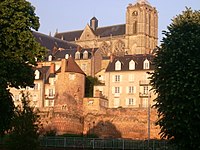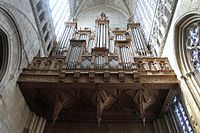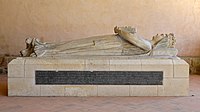Le Mans
Le Mans | |
|---|---|
Prefecture and commune | |
 Top row: left, Le Mans 24-hr automobile race in June; right, Le Mans Justice Department Office; Middle row: View of Sarthe River and historic area, including the Palais of Comtes du Maine; Bottom row: left, Le Mans Tramway in Gambetta Street; center, Facade built in Le Mans Commerce Center; right, Saint Julien Cathedral | |
| Coordinates: 48°00′28″N 0°11′54″E / 48.0077°N 0.1984°E | |
| Country | France |
| Region | Pays de la Loire |
| Department | Sarthe |
| Arrondissement | Le Mans |
| Canton | Le Mans-1, 2, 3, 4, 5, 6 and 7 |
| Intercommunality | Le Mans Métropole |
| Government | |
| • Mayor (2020–2026) | Stéphane Le Foll[1] |
| Area 1 | 52.81 km2 (20.39 sq mi) |
| Population (2021)[2] | 145,004 |
| • Density | 2,700/km2 (7,100/sq mi) |
| Demonym(s) | Manceau (masculine) Mancelle (feminine) |
| Time zone | UTC+01:00 (CET) |
| • Summer (DST) | UTC+02:00 (CEST) |
| INSEE/Postal code | 72181 /72000 |
| Dialling codes | (0)243 |
| Elevation | 38–134 m (125–440 ft) (avg. 51 m or 167 ft) |
| 1 French Land Register data, which excludes lakes, ponds, glaciers > 1 km2 (0.386 sq mi or 247 acres) and river estuaries. | |
Le Mans (
Its inhabitants are called Manceaux (male) and Mancelles (female). Since 1923, the city has hosted the 24 Hours of Le Mans, the world's oldest active endurance sports car race. The event is among the most attended and prestigious motor sports events in the world.
History
First mentioned by
As the use of the French language replaced late Vulgar Latin in the area, Cenomanus, with dissimilation, became known as Celmins. Cel- was taken to be a form of the French word for "this" and "that", and was replaced by le, which means "the".
As the principal city of
In the 13th century Le Mans came under the control of the French crown. It was subsequently invaded by England during the Hundred Years' War.[5]
Industrialization took place in the 19th century which saw the development of railway and motor vehicle production as well as textiles and tobacco manufacture.[5]
World War II
Soon after Le Mans was liberated by the U.S.
Main sights
- Le Mans has a well-preserved old town (Cité Plantagenêt, also called Vieux Mans) and the St Julian of Le Mans, who is honoured as the city's first bishop.
- Remnants of a Roman wall are visible in the old town and Roman baths are located by the river. These walls are highlighted every summer (July and August) evening in a light show that tells the history of the town.
- Arboretum de la Grand Prée
- Notre-Dame de la Couture, medieval church
- Notre Dame de Sainte Croix, neogothic church
- Part of the former Cistercian abbey de l'Epau, founded by Queen Berengaria and currently maintained in extensive grounds by the Département de la Sarthe.
- Jardin des Plantes du Mans
- Musée de la reine Bérengère, a museum of Le Mans history located in a gothic manor house.
- Camille Corot) and archaeological collections as well as decorative arts.
Gallery
-
Le Palais des Comtes du Maine[n 1]
-
Gallo-Roman walls
-
Organ in the cathedral
-
A street in the old town
-
Manhole cover depicting the city's coat-of-arms
-
Effigy of Berengaria of Navarre in the chapter house of Épau abbey.
Climate
Le Mans has a temperate oceanic climate (Cfb) influenced by the mild Atlantic air travelling inland. Summers are warm and occasionally hot, whereas winters are mild and cloudy. Precipitation is relatively uniform and moderate year round.
| Climate data for Le Mans (1991–2020 averages) | |||||||||||||
|---|---|---|---|---|---|---|---|---|---|---|---|---|---|
| Month | Jan | Feb | Mar | Apr | May | Jun | Jul | Aug | Sep | Oct | Nov | Dec | Year |
| Record high °C (°F) | 17.2 (63.0) |
21.8 (71.2) |
25.6 (78.1) |
30.3 (86.5) |
32.4 (90.3) |
39.7 (103.5) |
41.1 (106.0) |
40.5 (104.9) |
35.0 (95.0) |
30.0 (86.0) |
22.2 (72.0) |
18.3 (64.9) |
41.1 (106.0) |
| Mean maximum °C (°F) | 14.4 (57.9) |
16.2 (61.2) |
20.4 (68.7) |
24.8 (76.6) |
28.2 (82.8) |
32.4 (90.3) |
33.9 (93.0) |
34.0 (93.2) |
29.2 (84.6) |
23.5 (74.3) |
17.6 (63.7) |
14.3 (57.7) |
35.4 (95.7) |
| Mean daily maximum °C (°F) | 8.4 (47.1) |
9.7 (49.5) |
13.3 (55.9) |
16.6 (61.9) |
20.1 (68.2) |
23.6 (74.5) |
26.0 (78.8) |
26.0 (78.8) |
22.2 (72.0) |
17.2 (63.0) |
11.9 (53.4) |
8.8 (47.8) |
17.0 (62.6) |
| Daily mean °C (°F) | 5.5 (41.9) |
5.9 (42.6) |
8.7 (47.7) |
11.3 (52.3) |
14.9 (58.8) |
18.2 (64.8) |
20.3 (68.5) |
20.1 (68.2) |
16.7 (62.1) |
13.0 (55.4) |
8.6 (47.5) |
5.9 (42.6) |
12.4 (54.4) |
| Mean daily minimum °C (°F) | 2.7 (36.9) |
2.2 (36.0) |
4.0 (39.2) |
6.0 (42.8) |
9.7 (49.5) |
12.9 (55.2) |
14.6 (58.3) |
14.3 (57.7) |
11.2 (52.2) |
8.8 (47.8) |
5.2 (41.4) |
2.9 (37.2) |
7.9 (46.2) |
| Mean minimum °C (°F) | −6.1 (21.0) |
−5.1 (22.8) |
−3.0 (26.6) |
−0.6 (30.9) |
2.7 (36.9) |
6.8 (44.2) |
8.8 (47.8) |
7.7 (45.9) |
4.5 (40.1) |
0.8 (33.4) |
−2.8 (27.0) |
−5.2 (22.6) |
−8.0 (17.6) |
| Record low °C (°F) | −18.2 (−0.8) |
−17.0 (1.4) |
−11.3 (11.7) |
−4.9 (23.2) |
−3.7 (25.3) |
1.6 (34.9) |
3.9 (39.0) |
3.2 (37.8) |
−0.5 (31.1) |
−5.4 (22.3) |
−12.0 (10.4) |
−21.0 (−5.8) |
−21.0 (−5.8) |
| Average precipitation mm (inches) | 65.9 (2.59) |
49.1 (1.93) |
52.2 (2.06) |
51.1 (2.01) |
63.2 (2.49) |
55.1 (2.17) |
49.4 (1.94) |
49.0 (1.93) |
50.8 (2.00) |
65.5 (2.58) |
67.1 (2.64) |
75.0 (2.95) |
693.4 (27.29) |
| Average precipitation days | 11.0 | 9.6 | 9.4 | 9.0 | 9.5 | 7.9 | 7.3 | 7.1 | 7.7 | 10.6 | 11.3 | 11.6 | 112 |
| Average relative humidity (%)
|
87 | 83 | 78 | 74 | 75 | 73 | 72 | 74 | 79 | 86 | 88 | 88 | 79.8 |
| Mean monthly sunshine hours | 65 | 94 | 139 | 180 | 207 | 221 | 233 | 226 | 185 | 118 | 75 | 67 | 1,810 |
| Source 1: Meteo France[10]
| |||||||||||||
| Source 2: Infoclimat (humidity 1961–1990)[11] | |||||||||||||
Demographics
As of 2018[update], there were 367,082 inhabitants in the metropolitan area ( The population data for 1851 and earlier in the table and graph below refer to the pre-1855 borders.
|
| ||||||||||||||||||||||||||||||||||||||||||||||||||||||||||||||||||||||||||||||||||||||||||||||||||||||||||||||||||
| |||||||||||||||||||||||||||||||||||||||||||||||||||||||||||||||||||||||||||||||||||||||||||||||||||||||||||||||||||
| Source: EHESS[13] and INSEE (1968-2017)[14] | |||||||||||||||||||||||||||||||||||||||||||||||||||||||||||||||||||||||||||||||||||||||||||||||||||||||||||||||||||
Transportation
The
Sport
Motorsport


The first French Grand Prix took place on a 64-mile (103 km) circuit based at Le Mans in 1906.
Since the 1920s, the city has been best known for its connection with motorsports. There are two official and separate racing tracks at Le Mans, though they share certain portions. The smaller is the Bugatti Circuit (named after Ettore Bugatti, founder of the car company bearing his name), a relatively short permanent circuit, which is used for racing throughout the year and regularly hosts the French motorcycle Grand Prix. The longer and more famous Circuit de la Sarthe is composed partly of public roads. These are closed to the public when the track is in use for racing. Since 1923, this route has been used for the famous 24 Hours of Le Mans sports car endurance race. Boutiques and shops are set up during the race, selling merchandise and promoting products for cars.
The "
The 1955 Le Mans disaster was a large accident during the race that killed eighty-four spectators.
Basketball
The city is home to
The team plays its home games at the Antarès, which served as one of the host arenas of the FIBA EuroBasket 1999.
Football
Cycling
- Circuit de la Sarthe (cycling)
Notable people
Le Mans was the birthplace of:

- Elijah ben Menahem Ha-Zaken, born 980
- Henry II of England, born 1133
- Geoffroy V d'Anjou, born 1113
- Geoffrey de Goreham or Gorron, became Abbot of St Albans, Hertfordshire, UK in 1119
- John II of France, born 1319
- Dom Louis Le Pelletier, born 1663, linguist of the Breton language
- Gilles-François de Beauvais, born 7 July 1693, Jesuit writer and preacher
- Jean-Marie-Joseph Coutelle (1748–1835), engineer, scientist and pioneer of ballooning
- Basil Moreau, born 1799, priest of Le Mans, founded the Congregation of Holy Cross, beatified in Le Mans in 2007
- Léon Bollée, born 1870, car manufacturer and inventor
- Henri Fournier, born 1871, racing driver
- Jean Genêt's The Maids
- Jean Françaix, born in 1912, composer
- Jean Lucas, born 1917, racing driver
- Anny-Charlotte Verney, born 1943, racing driver
- François Migault, born 1944, racing driver
- Jean Rondeau, born in 1946, racing driver and constructor
- Gérard Tremblay, born 1950, racing driver
- Jean-Yves Empereur born 1952, archeologist
- Bertrand Lançon, born 1952, Roman history scholar
- François Fillon, born in 1954, former Prime Minister of France
- Yves Jumeau, born in 1955, visual artist
- François Vallejo, born 1960, novelist
- Sylvie Tolmont, born 1962, politician
- Lionel Robert, born 1962, racing driver
- Sabine Toutain, born in 1966, violist
- Doan Bui, born in the 1970s, journalist
- Amaelle Landais-Israël, born 1977, climatologist
- Emmanuel Moire, born 1979, French singer
- Sébastien Bourdais, born 1979, race car driver
- Julien Canal, born 1982, race car driver
- Jo-Wilfried Tsonga, born 1985, professional tennis player
- Guillaume Loriot, footballer
- Leslie, born 4 February 1985, French singer
- Louis Rossi born 1989, Grand Prix motorcycle racer
- Emma Mackey, born 1996, French-British actress
Notable residents include:
- Gilles Villeneuve, lived temporarily in Le Mans in 1973.
- Gérard Genette, literary theorist, lived and taught in Le Mans from 1956 to 1963.
- Jacques Derrida, philosopher, lived and taught in Le Mans in 1959–1960.
- David Jason, English actor, lived in Le Mans between 1965–1968 and 1999–2001.
- Andy Wallace, born 1961, racecar driver.
Died in Le Mans:
- Liborius of Le Mans (c. 348–397), bishop of Le Mans
- André d'Arbelles (1767–1825), journalist and historiographer
- Lawrence Aubrey Wallace (1857–1942) British Colonial Administrator
International relations
Le Mans is
Gastronomy
The culinary specialty of Le Mans is rillettes, a shredded pork pâté.
Landmarks
Located at Mayet near Le Mans, the Le Mans-Mayet transmitter has a height of 342 m and is one of the tallest radio masts in France.
Representation in popular culture
- Le Mans has been a setting for numerous feature films that feature its famous race.[17]
- Le Mans is a setting for sections of the 2020 novel, The Invisible Life of Addie LaRue, by V.E. Schwab.[18]
See also
- The Cenomanian Age of the Cretaceous Period of geological time is named for Cenomanus (Gallo-Roman Le Mans)
- Communes of the Sarthe department
Notes
- ^ birthplace of Henry II of England (now part of the Town Hall and not open to the public)
References
- ^ "Répertoire national des élus: les maires". data.gouv.fr, Plateforme ouverte des données publiques françaises (in French). 2 December 2020.
- ^ "Populations légales 2021". The National Institute of Statistics and Economic Studies. 28 December 2023.
- ^ Geography 2.8.8
- S2CID 162544388.
- ^ a b "Le Mans | History, Geography, & Points of Interest | Britannica". 11 June 2023.
- ISBN 0940053020.
- ^ Blumenson, Martin, Breakout and Pursuit, Center of Military History, United States Army, Washington, D.C., 1989, pp. 436–8
- ^ Johnson, David C. (1988), U.S. Army Air Forces Continental Airfields (ETO), D-Day to V-E Day; Research Division, USAF Historical Research Center, Maxwell AFB, Alabama.
- ISBN 0-89201-092-4.
- ^ "Données climatiques de la station de Le Mans" (PDF) (in French). Meteo France. Retrieved 10 September 2023.
- ^ "Normes et records 1961–1990: Le Mans – Arnage (72) – altitude 51m" (in French). Infoclimat. Retrieved 9 January 2016.
- ^ Comparateur de territoire: Aire d'attraction des villes 2020 du Mans (034), INSEE
- ^ a b Des villages de Cassini aux communes d'aujourd'hui: Commune data sheet Le Mans, EHESS (in French).
- ^ Population en historique depuis 1968, INSEE
- ^ "Le Mans light rail takes off". Railway Gazette International. 6 January 2008. Archived from the original on 16 June 2011. Retrieved 5 March 2010.
- ^ "Les jumelages". lemans.fr (in French). Le Mans. Retrieved 14 November 2019.
- ^ "The 5 Best 24 Hours of le Mans Movies". 14 June 2016.
- ^ "The Invisible Life of Addie LaRue: Recap & Summary". The Bibliofile. 5 October 2020. Retrieved 15 February 2022.
Bibliography
External links
- Official website (in French)
- Le Mans d'Antan (in French)





![Le Palais des Comtes du Maine[n 1]](http://upload.wikimedia.org/wikipedia/commons/thumb/e/ea/Palais_des_comtes_du_Maine_-_Le_Mans.jpg/200px-Palais_des_comtes_du_Maine_-_Le_Mans.jpg)





